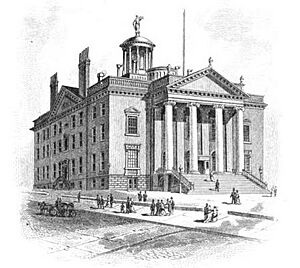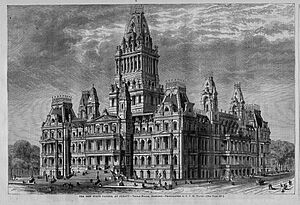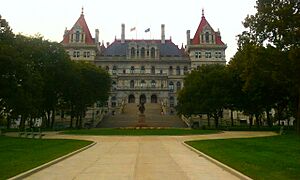New York State Capitol facts for kids
Quick facts for kids New York State Capitol |
|
|---|---|

The New York State Capitol viewed from the southwest
|
|
| General information | |
| Architectural style | Romanesque Revival, Neo-Renaissance |
| Town or city | Albany, New York |
| Country | United States |
| Construction started | 1867 |
| Completed | 1899 |
| Cost | $25 million |
| Client | State of New York |
| Design and construction | |
| Architect |
|
|
New York State Capitol
|
|
|
U.S. Historic district
Contributing property |
|
| Part of | Lafayette Park Historic District (ID78001837) |
| NRHP reference No. | 71000519 |
| Significant dates | |
| Added to NRHP | February 18, 1971 |
| Designated NHL | January 29, 1979 |
| Designated CP | November 15, 1978 |
The New York State Capitol is a very important building in Albany, New York, which is the capital city of New York. It is where the New York state government works. This building is part of the Empire State Plaza complex. It houses the New York State Legislature, which is where state laws are made.
The Capitol was finished in 1899. It cost about $25 million, which was a huge amount of money back then. This made it the most expensive government building of its time. The Capitol is also a historic landmark. It was added to the National Register of Historic Places in 1971. Later, in 1979, it was named a National Historic Landmark.
Contents
History of the Capitol Building
Before Albany became the state capital in 1797, state lawmakers met in different buildings. From 1797 to 1811, they met at the Old Albany City Hall. The first official State Capitol building was designed by Philip Hooker. It opened in 1812 and was used until 1879.
Building the Current Capitol
The Capitol building you see today was built between 1867 and 1899. It took 32 years to complete! Three different teams of architects worked on its design.
- The first architect was Thomas Fuller, from 1867 to 1875. He was an English architect who also designed the Parliament buildings in Ottawa, Canada.
- Next were Leopold Eidlitz and Henry Hobson Richardson, from 1875 to 1883.
- Finally, Isaac G. Perry finished the project from 1883 to 1899.
Fuller designed the ground floor in a Classical/Romanesque style. But he was later replaced. Eidlitz and Richardson then designed the next two floors. These floors have a Renaissance Classical style with light, open columns.
The cost of building the Capitol kept going up. This caused many arguments among the lawmakers. It was hard to get enough money to finish the project. Eidlitz and Richardson were also replaced because of the rising costs. Isaac G. Perry was hired to complete the building.
The upper floors, including the legislative chambers and the roof, were finished in a Victorian-modified Romanesque style. This style is known as Richardsonian Romanesque. Many people say that Richardson's design really shaped the final look of the grand building. Some even say he was inspired by the City Hall in Paris, France. The stone used for the building came from a quarry in Essex County, New York.
Capitol's Unique Features
The Capitol was planned to have a huge dome and tower in the center. However, these were never finished. The building was so heavy that it started to crack and shift downhill! To stop this, a large, 166-foot-long staircase was added to the front. This staircase helps support the building.
The outside of the Capitol is made of white granite from Maine. Some parts also use marble cut by prisoners. The building is 220 feet tall at its highest point. It is one of only a few state capitols in the U.S. that does not have a domed roof. Tunnels connect the Capitol to the Empire State Plaza and another building nearby.
From 2000 to 2014, the outside of the Capitol was repaired and restored. Many old details were brought back to life. A skylight over a large staircase was uncovered and fixed. The roof tiles were also replaced with new ones that looked just like the originals.
The Assembly Chamber inside the Capitol was built with a very wide arched ceiling. But this caused problems with sound. Also, the building's shifting foundation made the ceiling unstable. A lower, false ceiling was added to prevent pieces of rock from falling.
Art Inside the Capitol
The Capitol once had two huge paintings by artist William Morris Hunt. These paintings were called The Flight of Night and The Discoverer. Each was about 45 feet long and painted directly on the walls of the Assembly Chamber. Sadly, these murals were later covered up when the ceiling was lowered. They had also been damaged by moisture.
In the Governor's Reception Room, also called the War Room, you can see ceiling paintings of battle scenes. These were created by William de Leftwich Dodge.
Outside the Capitol, there is a statue of Civil War General Philip Sheridan on horseback. It was designed by John Quincy Adams Ward and Daniel Chester French and finished in 1916.
The 1911 Fire
In the early morning of March 29, 1911, a big fire started in the Assembly library. No one knows for sure what caused it. Some people think it was an electrical problem, while others believe a cigar was dropped. One night watchman sadly died in the fire.
The fire destroyed almost the entire collection of the New York State Library. Many documents and artifacts from the New York State Museum were also lost. The flames reached 200 feet high at one point! It took 125 firefighters to put out the fire.
The heat from the fire was so strong that it twisted metal and melted stone. The southwest part of the building was badly damaged. It took three months to clean up the mess and a year to rebuild that section. The repairs cost $5 million.
Visiting and Tours
The New York State Capitol is open to visitors from Monday to Friday, 7 a.m. to 7 p.m. It is usually closed on weekends and holidays. You can take a guided tour of the Capitol. Tours start at the Information Desk in the State Street Lobby. There is also a Visitor Center for the Capitol and Empire State Plaza. It is located on the Concourse Level of the Plaza.
Images for kids
-
The Capitol viewed from the Corning Tower
-
Panorama of the New York State Assembly Chamber
-
Panorama of the New York State Senate Chamber
-
Outside the New York State Senate viewing gallery
-
A statue of George Washington northwest of the capitol
See also
 In Spanish: Capitolio del Estado de Nueva York para niños
In Spanish: Capitolio del Estado de Nueva York para niños
- List of New York State legislatures
- List of National Historic Landmarks in New York
- List of tallest buildings in Albany, New York
- National Register of Historic Places listings in Albany, New York
- List of state and territorial capitols in the United States























